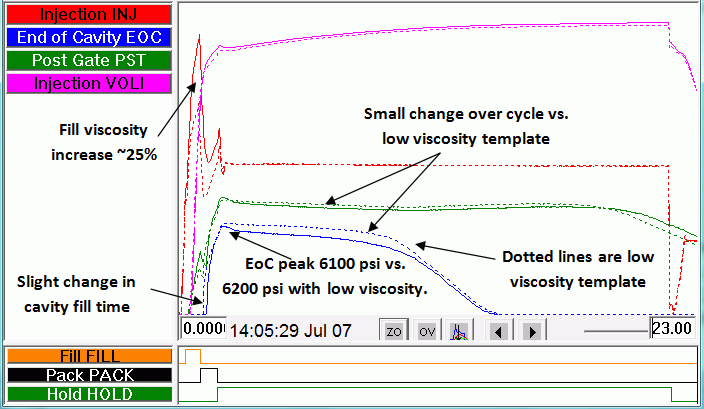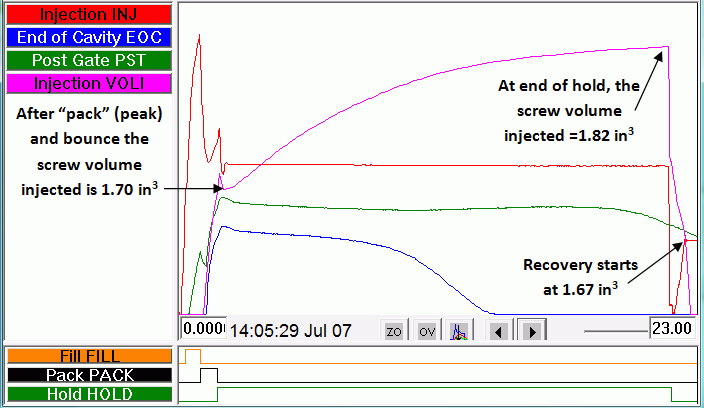Tip of the Day 178: When “Hold” Isn’t Hold in Decoupled III
Once upon a time a customer complained using Decoupled III “didn’t work.” After wiping some egg off of our faces we found out what he meant: That D3 did not control the part dimensions when viscosity varied. We can show that D3 does control the process in almost all cases better than D2. So why not the dimensions?
Let’s start with a look at the process graph:

You can see that the Decoupled III process control did a reasonably good job of controlling the cavity pressures, especially the peaks. Decoupled III is a process of filling fast to a machine position, packing with a steady machine speed to a cavity pressure and switching to hold to keep the material in the part until the gate seals.
You may notice that the hold time is quite long and the cavity pressure near the gate stays high for that whole time. This part is mostly thick-walled. Also, the reasonably sudden roll-off of end of cavity pressure tells us this is probably a semi-crystalline material.
Now let us look at the motion of the screw during hold ‡. This is easier to see if we expand the scale, making the high edge of the graph window 1.85 in3 and the low edge 1.6 in3.

If D3 is supposed to pack to a cavity pressure and then hold the material in, why did the screw move 7.2%† of the total volume required AFTER pack?
Shrinkage.
With semi-crystalline materials, the molecules “cuddle” together as they crystallize. As the material transitions from melt to solid the material very suddenly requires much less volume. This makes more room for more material to flow into the mold as the material freezes from the walls inward. This is sometimes called “compensation flow.” So the “hold” phase is not really holding but is still feeding material in as the freezing material shrinks. In amorphous parts this percent after pack is commonly less than 1%.
What happens when the viscosity increases?
If you apply a constant pressure to a fluid (plastic) to make it flow (hold pressure) and viscosity increases, then flow decreases. But the freezing rate stays the same based on heat transfer. When remote areas of the part freeze they may not have had time to accept all the molecules required to hold a dimension.
What does this mean to you?
- In this class of part, flow does NOT stop when the cavity is “packed” to a peak pressure.
- Cold gate designs must account for the required shrinkage flow and stay open as long as necessary.
- Valve gates must stay open long enough to account for shrinkage flow.
- If the gates close too early then voids and sinks are probable.
- If viscosity increases, fewer molecules fed in during hold can mean more shrinkage and a shorter part.
- To control dimensions, track viscosity variation and modify the process as necessary to restore them when viscosity changes.
Quiz question:
Which molding “quadrant” is this? (from tip 177). How does it differ from the opposite quadrants?
‡ Some screw motion could be due to leakage of the check-ring (or non-return valve). Looking at these details requires a good seal on the screw. Leaking check-rings the the screw move forward forever under pressre, even with very long hold times (runner frozen) and they move with a constant speed: a non-changing slope on volume curve. The one in this example was good.
